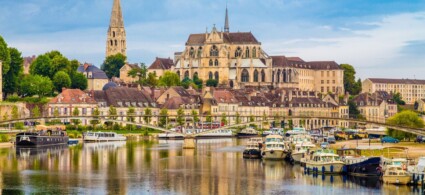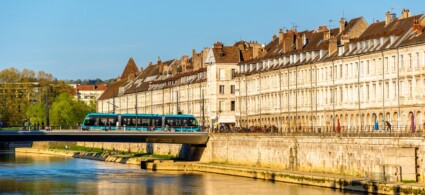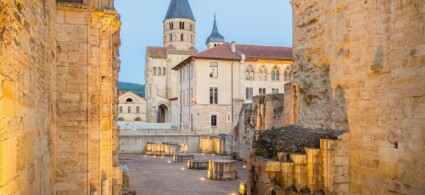Burgundy is a vast region in central-eastern France nestled between the Loire Valley, the Auvergne Rhône-Alpes and Alsace.
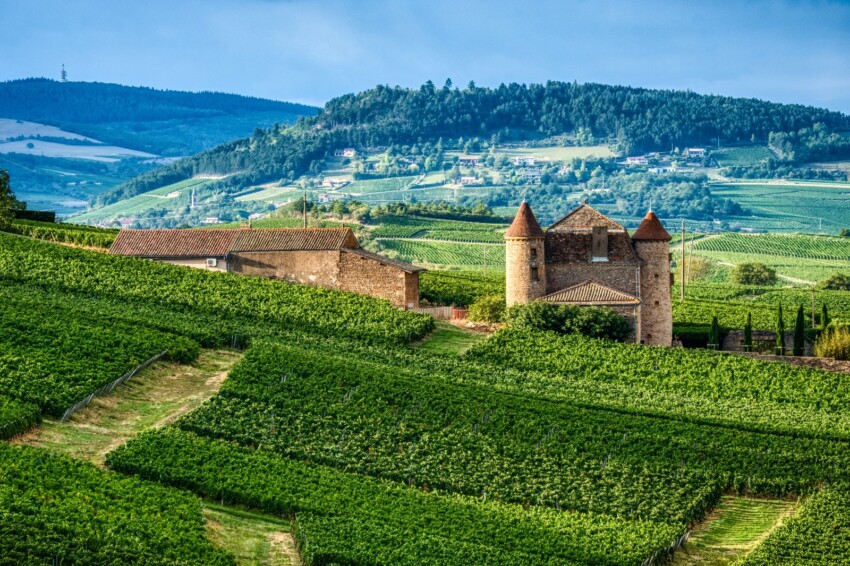

Burgundy is located in the central-eastern part of France and after the administrative reform of 2016, it was merged with the Franche-Comté region, thus creating the new Burgundy-Franche-Comté.
Renowned for its prestigious wines, such as Pinot Noir and Chardonay, Burgundy proves to be the custodian of a very rich territory from both a historical and cultural point of view: its green valleys are dotted with beautiful castles and characteristic villages.
Undoubtedly, Burgundy owes its fame to the prestigious vineyards where the world’s best pinot noirs are produced. But this enchanting region also possesses a vast historical and cultural heritage, thanks to wonderful cities of art and history.
In addition, Burgundy, characterised by gentle rolling hills covered with vineyards, also boasts varied landscapes of enchanting forests, mysterious forests and waterways that run past abbeys, castles and small villages.

A tempting destination for a gastronomic and cultural trip, a fabulous destination for history buffs, with its half-timbered houses and unparalleled urban network, Dijon is a UNESCO World Heritage Site.
Follow the owl’s footpath and admire the former capital of the Dukes of Burgundy, discovering the most fascinating corners of the completely pedestrianised old town: Romanesque and Gothic churches, ancient palaces and medieval streets.
You will be enchanted by the majestic Palace of the Dukes, the city’s most emblematic monument, which houses the town hall accompanied by the Philippe le Bon tower, a 15th-century watchtower from the top of which you can admire a panoramic view of the city’s rooftops.
But Dijon is also the gastronomic and wine capital of Burgundy and will tickle your taste buds with its fine wines and culinary specialities such as mustard dishes, snails in sauce, crème de cassis, chocolate desserts and gingerbread.
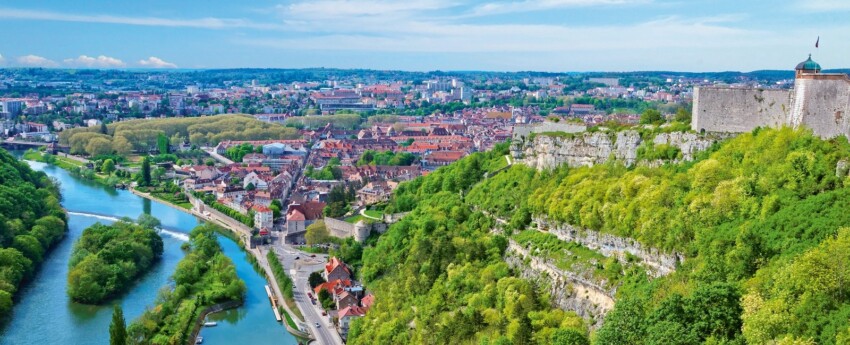
The emblem of Besançon is undoubtedly the famous Vauban citadel, a UNESCO World Heritage Site, which stretches over 12 hectares on a ridge overhanging the city centre.
An admirable example of 17th-century military architecture, the citadel is considered one of the most beautiful in France and offers wonderful views from its ramparts. Today, the Citadel houses three museums: the Comtois Museum, the Museum of Biodiversity and the Museum of Resistance and Deportation.

The medieval city of Cluny is mainly known for its abbey, built in 910: it was the most powerful Benedictine Abbey in the West and still preserves traces of its prestigious past. Visit the Clock Tower, the Eau Bénite bell tower, the Jean de Bourbon chapel, the convent buildings, the cloister and the ancient Farinier, which boasts finely sculpted capitals.
The medieval village is also wonderful, all to be discovered on foot, walking through its narrow alleys. Don’t forget to climb to the top of the Tour des Fromages, which offers an exceptional panorama of the town.
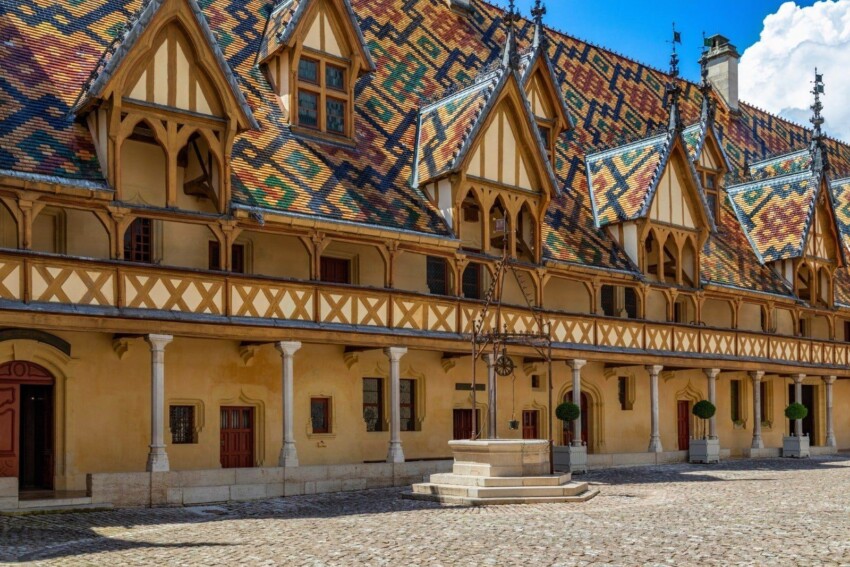
Built by Chancellor Nicolas Rolin in the 15th century, Beaune’s hospitals were intended to welcome the sick, the elderly, the destitute, orphans and invalids during the devastation of the Hundred Years’ War and the plague epidemic. Built in 1443, they remained in operation for 116 years.
These Gothic buildings, made famous by their enamelled tiles and polychrome roofs, are a true jewel of Burgundy: don’t miss a visit to the large and magnificent Salle des Pôvres of the Hotel-Dieu.

At the gateway to the region, Auxerre is undoubtedly the most charming city of art in all of Burgundy and, after Dijon, has the largest pedestrian zone.
The best views are definitely from the footbridge over the Yonne River. After visiting the Saint-Etienne cathedral, a jewel of Gothic art, and the Saint-Germain abbey, we recommend that you lose yourself in the medieval alleyways of the old town, in search of picturesque views and corners to photograph.
La Charité-sur-Loire is located on the route taken by pilgrims on their way to Santiago de Compostela. It has a glorious past as a town flourishing in trade, surrounded by imposing defensive bastions and guardian of outstanding masterpieces of Romanesque architecture, such as its Cluniac priory. This Benedictine monastery of the Cluny order, founded in 1059, is, together with its UNESCO heritage church, an important example of Burgundian Romanesque architecture.
It is enchanting to stroll through the typical cobbled streets that welcome artists and artisans, sampling the delights of the priory’s patisserie, the gourmets’ landmark.
A city of art and history, Autun has an exceptional heritage, reflecting a prestigious history that began more than two millennia ago.
In fact, two eras can be visited in the town: the ancient era, with a dozen archaeological sites such as the ancient theatre, temple, ramparts and gates, and the medieval era, symbolised by the Saint-Lazare cathedral, one of the greatest works of Cluniac art, built between 1120 and 1130. Resplendent in its architectural perfection, the cathedral boasts a sculptural representation of the Last Judgement in the tympanum, biblical scenes in the capitals, the famous ‘Eve’ (on display at the Rolin Museum), all by the sculptor Gislebertus.

In the heart of the unspoilt nature of the Auxois, an impeccably preserved Cistercian abbey, declared a UNESCO World Heritage Site, awaits you.
The beauty of the Romanesque buildings, flanked by admirable gardens, make it an exceptional place where calm and serenity reign. The ideal place to encounter the world of the Cistercian monks and their conception of life and religion. In fact, the abbey represents an ideal city isolated in the middle of the woods, completely self-sufficient and equipped with a church, cloister, refectory, dormitory, bakery, forge, vegetable garden and farm.
Despite its nine centuries of history, this majestic complex has kept all its buildings intact and offers the incredible spectacle of its beauty and the purity of its lines, all in white and ochre stone in the heart of lush vegetation.

Perched on the bend of the Armançon river, the red-roofed medieval village stands on a promontory of pink granite. Passing through the Sauvigny and Guillier gates, one discovers the charm of the cobbled streets lined with half-timbered houses, the elegance of the Gothic collegiate church, the power of the donjon and ramparts climbing the rock and the picturesque rue Chaude.
Full of charming corners such as the wash-house in Quai Baudon and the Chemin des Foulons, the town of Semur-en-Auxois is a little-known jewel.
This village in the heart of Burgundy has radiated a religious aura since the 12th century, with the construction of the Romanesque basilica of Sainte-Madeleine, a Unesco World Heritage Site: a monument of Christianity, a masterpiece of Romanesque art, magnificently restored by Viollet-le-Duc in the 19th century.
Nicknamed the ‘eternal hill’, you can admire a bucolic landscape that has seen pilgrims converge from all over Europe for 1,000 years to venerate the relics of Saint Magdalene, before continuing on to Santiago de Compostela. The basilica is surrounded by vineyards and Renaissance houses, cobbled streets, all perfectly preserved.

A historic town at the gates of the Morvan, perched on a granite spur and surrounded by ramparts, it dominates the magnificent valley of Cousin, surrounded by its mythical terraced gardens cultivated since the 10th century.
Protected by large walls, Avallon is a charming town that boasts a series of splendours within its historic centre: the collegiate church of Saint-Lazare, whose origins date back to the 8th century, the 49-metre-high Clock Tower built in 1456 on the site of the old castle gate, the 15th-century houses of the Lords de Domecy, typically Burgundian, the salt granary, ramparts and watchtowers.

Surrounded by moats and set in a beautiful park, the Château de Tanlay is one of the most beautiful Renaissance residences in Burgundy .
Built in the 16th and 17th centuries by the Coligny family during the Wars of Religion, it became an important meeting place for Huguenot leaders. Particelli d’Hemery, superintendent of finance close to Cardinal Mazarin, completed the work by building the beautiful complex that we see today, with the help of the famous architect Le Muet.
Today, this building welcomes travellers from all over the world, attracted in particular by its trompe-l’oeil gallery, the frescoes of the League Tower and its enchanting garden. In addition, Tanlay Castle regularly organises themed events.
Surrounded by greenery, the Château de Bazoches holds many memories of Marshal Vauban. In fact, the famous military engineer acquired the former 12th century medieval fortress with a concession from Louis XIV after the capture of the city of Maastricht.
Vauban made several improvements to the castle: he built a large gallery overlooking the valley and installed the engineering services working under his aegis. It is here, in Bazoches, that the plans for the 300 fortifications designed by Vauban for the Sun King will be drawn.
You can visit his office, his bedroom, his armour, his genealogy, the room of relief maps: everything is still permeated by his extraordinary personality.

For lovers of hiking, horse riding or cycling, the Roche de Solutré is a must-see place in Burgundy.
Not only is the site full of marked trails, but it also offers an exceptional panorama of the region’s vineyards. Lovers of prehistory can visit the numerous sites in La Roche.
The Morvan region is a land of water and greenery that will enchant bucolic hikers and thrill-seeking sports enthusiasts.
In the park, one can go canoeing, rafting or simply bathe in the cold and mysterious waters of its waterfalls. In fact, the Morvan has no less than 6 large artificial lakes: Lake Pannecière, Crescent, Saint-Agnan, Chaumeçon, Chamboux and the best known, Lake Settons, which is very popular and used for water sports, excursions and boat trips.
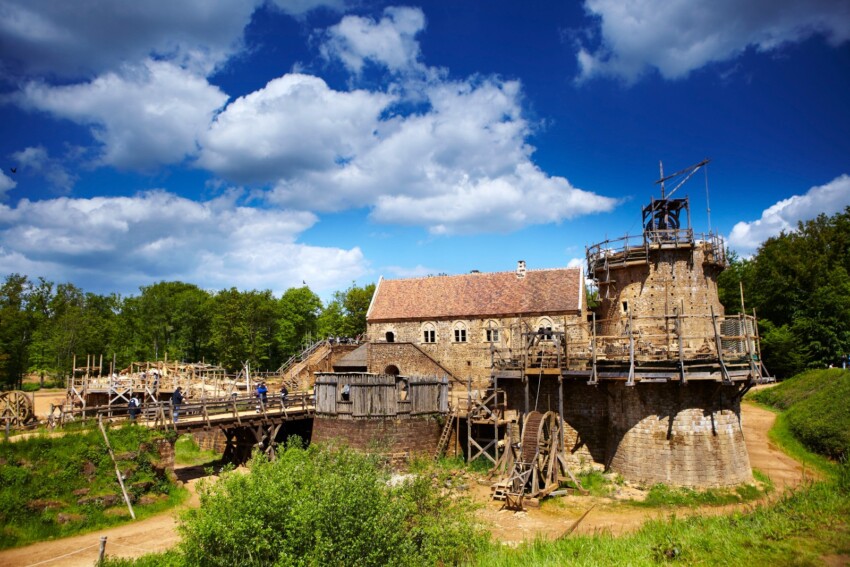
For over 20 years, an extraordinary adventure has been taking place in the heart of Puisaye, almost on the outskirts of Paris: the construction of a fortified castle using 13th century methods. A fantastic medieval building site that has mobilised some 50 craftsmen: stonemasons, masons, woodcutters, blacksmiths, potters, ceramists, sculptors, all working with ancient techniques. At the Château de Guédelon, in fact, there are no power generators or modern machinery. Teams of archaeologists, historians and craftsmen strive to reproduce the methods in use in the 13th century.
A visit to this château-d’oeil is truly unusual: it will allow you to take a real journey back in time, where you can meet and talk live with the workers and craftsmen in action who will share with you the wonderful adventure of the builders of the Middle Ages.
In the following map you can see the location of the main places of interest mentioned in this article

Much more than a simple drink, wine in Burgundy is part of a real culture: it is at the origin of many landscapes, traditions, small and great stories.
Essential and inimitable, the great wines of Burgundy owe their reputation to the richness of their terroirs, the passion of their people and their emblematic vines: Chardonnay, Pinot Noir but also Gamay and Aligoté. Burgundy boasts 30,000 hectares of vineyards, has five wine regions and has been awarded 84 prestigious appellations.
It is therefore impossible to visit Burgundy without trying a wine tasting, one of the top experiences to have in this wonderful region. This is why 6 tourist routes have been designed to experience the whole region through the discovery of its white, rosé and red wines.
There are many ways to dive into the heart of the vineyards: you can choose routes on foot, by bicycle, by car, to explore these lands, admire superb landscapes and understand where the great Burgundy wines are born. The more adventurous can also try original formulas such as a ride on an all-terrain electric scooter, a flight in an ultralight or aboard a hot-air balloon.
This is the oldest wine route in France. Together with this route, a new way of travelling was born: wine tourism, a form of local tourism based on the discovery of wine regions and their productions.
Following this route, you will stop in 37 villages and 2 legendary towns, Dijon and Beaune. You will discover the hidden side of Burgundy’s winemaking tradition and taste the red, white and rosé wines that make it famous. The Route des Grands Crus represents 60 kilometres of olfactory revelations and delights.
To the north of the Côte-d’Or, the vast expanses and verdant landscapes of the Châtillonnais make this route truly interesting: its 120 kilometres cross the 23 municipalities classified as AOC Crémant de Bourgogne.
You have the opportunity to visit some places linked to wine and local history: the famous Trésor de Vix in Châtillon-sur-Seine, the Ampélopsis wine centre, the castle of Montigny-sur-Aube.
In the heart of the Chalonnaise territory, you will discover a vineyard that dates back to the Middle Ages and the Cluniac monks.
In this area, you will taste the famous red wines of Rully or Mercurey. Not forgetting the white wines including the famous Givry, which would have been Henry IV’s favourite wine.
Just 1 hour from Lyon, you can follow this tourist route that will take you to the heart of areas rich in extremely varied regional appellations. Let us mention the well-known Beaujolais or the famous Pouilly-Fuissé, a dry white wine with delicate and subtle flavours.
This route in the extreme south of Burgundy sometimes reveals a climate with southern accents that smells of holidays of yesteryear.
This route allows you to escape the hectic pace of Paris and regenerate among nature, vineyards and rivers.
Your taste buds and eyes will be surprised by the diversity of flavours and landscapes on the Route des Vignobles de l’Yonne, a tourist route comprising five circuits around the different vineyards of Icaun and dotted with historical and cultural sites.
There is a part of Burgundy that runs along the right bank of the Loire.
This circuit will take you to the land of the Pouilly-Fumé and Pouilly-sur-Loire vineyards, produced from Sauvignon and Chasselas grapes respectively.
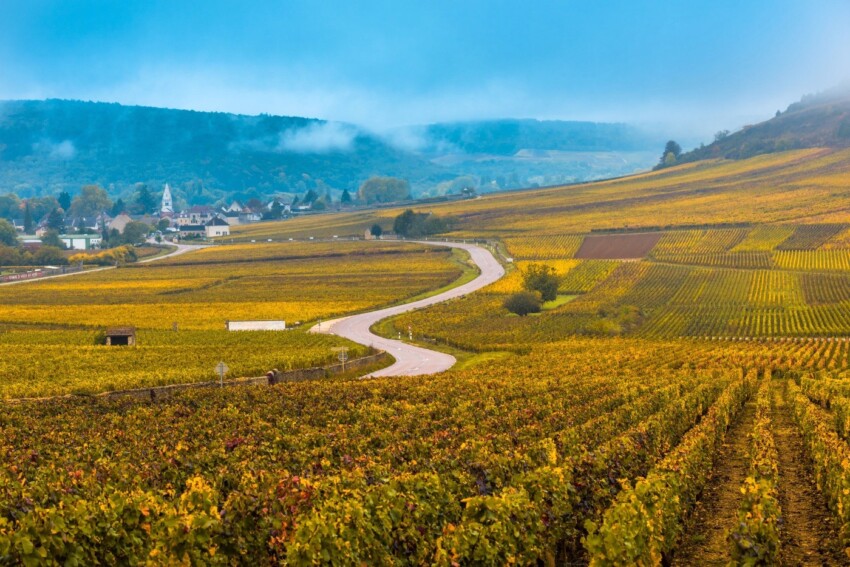
Burgundy possesses a bucolic and delightful landscape in every season of the year, but there is one moment when it unleashes all its charm and beauty at its most dazzling: autumn.
Indeed, in autumn, the landscapes of Burgundy are dressed in their finest clothes. With the arrival of the first mists and the first chill, the vineyards of the Route des Grands Crus light up with incredible colours, creating a sublime mosaic as in the Morvan, where the valleys take on fiery orange hues. Forests, hills, forests, landscapes and vineyards are covered in orange vegetation and the fiery sunsets will thrill you.
In addition, in the autumn calendar of Burgundy, the grape harvest begins between the end of August and the beginning of September: the vineyards are populated by workers who, armed with baskets, fill them with ripe grapes as they walk between the rows full of bunches. Some estates offer the opportunity to actively participate in the harvest and grape picking.
Also not to be missed are the numerous musical events and festivals, such as the legendary Hospices de Beaune Wine Sale, the Musique au Chambertin, the Djazz Nevers Festival, the Livres en Vignes fair at the Château du Clos de Vougeot.
Even at the table, autumn offers the most unexpected surprises. With its 28 starred chefs, Burgundy shines on the gastronomic scene all year round, but in autumn the dishes offer the most incredible flavours: the table welcomes truffles and mushrooms that awaken the taste buds, just like freshly harvested grapes.
Burgundy has a strategic location, and some of its major towns often become stopovers for tourists travelling to the Loire Valley, Normandy, Brittany, Paris or Disneyland: a great opportunity to treat yourself to a gastronomic and oenological break before arriving at your destination.
The closest airports to Burgundy are certainly those in the French capital, such as Paris Orly International Airport, Paris-Charles de Gaulle, Paris Beauvais, which are a 3- to 4-hour drive from Dijon.
Alternatively, you could also consider landing at Lyon Saint Exupéry Airport, a 2-hour drive from the Burgundy capital, or Strasbourg Airport, also 3½ hours away from Dijon.
You could opt for a fly&drive by landing in Paris, for example, where you can rent a car directly at the airport and then continue your journey to Burgundy. Calculate that the distance between Paris and Dijon is about 330 kilometres to be covered in 3 hours by car following the A6 motorway.
Those who enjoy travelling by train will be able to take advantage of the TGV network: many towns in Burgundy are served quickly and frequently by connections departing from Paris. You can thus choose from several daily TGV trains from Roissy Charles de Gaulle airport and from Paris, from the Gare de Lyon Station.
The TGV fast train network quickly reaches several towns in Burgundy in addition to Dijon: Montbard, Le Creusot – Montchanin – Montceau-les-Mines, Mâcon-Loch. Once you have arrived in these towns, you then continue by interregional trains to the main tourist resorts in the region.
Burgundy is a vast region in central-eastern France nestled between the Loire Valley, the Auvergne Rhône-Alpes and Alsace.

